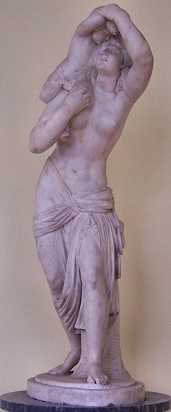Cognacq-Jay Museum 1, 2, 3 |
|
 |
Getting to the Cognacq-Jay MuseumThe Cognacq-Jay Museum sepecialises in art from the 18th century. It is located at 8 rue Elzévir. The nearest metros are Saint-Paul, Chemin-vert or Rambuteau. Buses are 29, 69, 76 and 96. It is run by the City of Paris so entrance is free. It is open from Tuesday to Sunday, except on public holidays, from 10:00 - 18:00. History of the Cognacq-Jay MuseumErnest Cognacq was born on the Isle de Ré in 1839. He had intended to train to go to sea, but his father died when he was 11, and his family could no longer afford to educate him. He walked to Paris to get work. After being rejected a few times he found work in a shop, and started to learn the trade and save up to open his own shop. When he had enough money he opened a shop, but it failed and he lost everything. So he started to save again. During this time he met Marie-Louise Jay. She worked in Bon Marche, a smart department store, but they decided to stay single until Ernest had enough money to open another shop. Eventally, by the time he was 32 and she 33, he had enough money to open another shop, although this "shop" was nothing more than a stall covered by an umbrella on the Pont-Neuf on the site of the old pump called La Samaritaine. So he called his shop La Samaritaine. |
 |
|
|
Louise was thrifty and they both worked very hard. Le Bon Marche, where she had previously worked, used to display the prices of the goods for sale quite openly for all to see (a novelty in those days), so customers could clearly see whether or not they could afford to buy. So Ernest and Louise decided to do the same. Another inovation was to let customers try on clothes before buying. Their business prospered and expanded until it became the famous art deco Samaritaine department store that closed just recently. They were very good to their workers, and way ahead of their time in the benefits they offered such as creshes and health care. They even gave their employees a share of the profits. Even so, they became very rich, and started to collect art. When they died they left their collection to the City of Paris. Originally the collection was kept in one of their houses in Blvd. des Capucines (bordering the 2nd and 9th arrondissements). It was moved to its current location (Hotel Donon) in 1980. Hotel DononHotel Donon was built in 1575 for the advisor of Catherine de Medici. In those days the fashion was for high-ceilinged rooms. This is why the panelling taken from the Blvd des Capucines house does not reach the ceiling. Ernest and Louise had no children of their own, but loved children as can be seen from the many over-door panels (see below). Above left and right marble busts of Ernest and Louise. Above left La bacchante au faune perché in marble by Jean-Joseph Foucou (1739 - 1815). Right L'amour et la fidélité (1787) by Claude-André Deseine. |
 |
  |
Left two over-door painted wood panels. Right Les demenagements (1822) by Boully. Unlike most other painters of the time he was interested in the lives of the bourgoisie, so painted them instead of the more usual classical or noble subjects. In this painting shows a family moving home. |
 |
 |
Left a painting by Jean-Baptiste Pater (1695 - 1756). Right a porcelain Sevrès painted clock from the 18th century. In the museum there are a large number of clocks and most of them are in working order as you will find out when they strike and chime the hours. |
 |
 |
copyright2003-2012 |




